The cold winter air returned today, and along with it, crystal clear views. I bicycled up to Mt. Davidson and hiked up to the summit for this big view. History is packed into every view in San Francisco and this hilltop is no exception. Here I am followed by three shots of the view from 1939, 1994 and today.
1939
1994
February 15, 2006
Three years ago, February 15 ’03, uncountable millions around the world demonstrated against the impending U.S. invasion of Iraq. It was pretty exhilarating at the time, but three years later, it marks an anniversary that most of us can only ruefully acknowledge: It was the day that mass demonstrations per se were categorically repudiated by the U.S. government. In Nixon’s day, the million marchers on Vietnam Day are reputed to have dissuaded him from dropping a nuclear bomb on Hanoi. Three years down the road, the Cheney/Bush gang have shown repeatedly that they don’t care about public opinion, or simple human compassion, or anything but their own power and wealth. In Iran they seem to be preparing again to shoot first and forget the Geiger counters, though many think the military is stretched much too thin to embark on any further “˜adventures.’
On today’s Democracy Now, Institute for Policy Studies’ analyst and author Phyllis Bennis echoed the themes laid out earlier by Jonathan Schell in The Unconquerable World (and other thinkers elsewhere), that the mass demonstrations of 2/15/03 were a harbinger of the new “˜other’ superpower: the international public. I wish I really believed it, and when I heard Bennis today it only reminded me of how often progressive politics these days depends on wishful thinking and earnest exhortation.
I’ve been arguing lately here that the forms are the problem. Demonstrations make me feel weak and stupid, and anyway, they don’t even come close to achieving the instrumental goals set out by organizers, or fervently wished for by participants. I still think we have to seize public space, animate ourselves as a public, figure out how to have conversations and talk to each other in public better, and so on. But the tired old form of the mass march under monitors and microphones has clearly lost whatever political power it once may have had.
Nevertheless, it is crucial that we remember our own actions, our own accomplishments. Part of why we started Shaping San Francisco was to have a place where we can record our own lived histories, which would otherwise go down the memory hole with so much else. The Gulf War demonstrations of 1991 were huge here, but just a few months later I was in conversation with people who had been at the 100,000+ march in January ’91 and they claimed there hadn’t been an anti-war movement since Vietnam! Even earlier evidence for the sense of impotence most people are left with after attending even large demonstrations.
We can find our history on the walls, often better than we can discover it in the media. The mural scene in San Francisco has its own historic roots, going back to the early part of the 20th century and then in the late 1920s when Diego Rivera and Frieda Kahlo came to San Francisco. I happened to go out bicycling last weekend, taking a long loop around McLaren Park and then past City College and over the flank of Mt. Davidson. I took the opportunity to drop in on the Diego Rivera mural at City College, “Pan-American Unity,” and here are a few images from it. He’s such an astounding muralist, it’s easy to forget if you don’t go and look at his work in person (seeing a bunch of his murals a couple of years ago in Mexico City was a fantastic treat).
This part of the much larger mural shows variations on Charlie Chaplin in The Great Dictator, and some WWII villains:
Rivera draws heavily on the romantic images of Tenochitlan, the original Mexico City. The sense of long-term history always impresses me, whatever one might think of its relative romanticization.
This part references his early City Club Mural with a look at the 1939 San Francisco. This Pan-American Unity mural was originally painted and installed at the 1939 World’s Fair at the then-just completed Treasure Island.
Murals in San Francisco are a vital connection to otherwise lost history. Thanks to Mona Caron’s Market Street Railway mural, there is a good visual memorial of our local Feb. 15 03 march. Here’s a couple of images from that, but you should check out the whole thing from that link.
And then there’s the odd truth that murals don’t always last a whole lot beter than our own memories. So much of how we construct our memories has to do with the visual environment, with the places and buildings and streetscapes we see every day, where our lives unfold and gain depth. Here are two murals by Juana Alicia on the same wall. The first one, Las Lechugeras (the Lettuce Pickers) eventually faded and got scarred with graffiti.
Now she’s painted this magisterial blue water mural La Llorona (Alicia retains the copyright to her images so if you want to use them for anything beyond personal use in this low-resolution format, do contact her directly please.)
Lots of purty pictuers today…
I was just talking last night about the rise of visual memory as a function in part of literacy. Prior to literacy, oral storytelling was the credible source of truth and knowledge. Nowadays, we need the pictures, we need to read the facts, we need to see it to believe it.
And yet, in spectacular society, there is no certain truth in what we see, in fact the carefully constructed simulations of real news and real events move us ever further from anything we could call ‘true.’ The true is a moment of the false, to quote Debord, and we get to live that jarring reality every day.

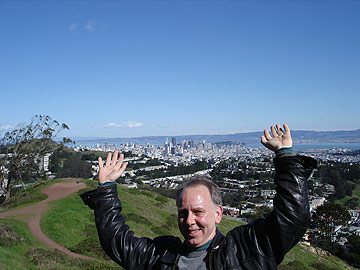
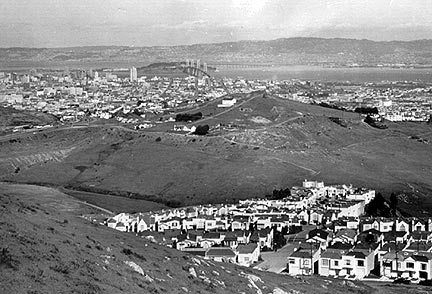
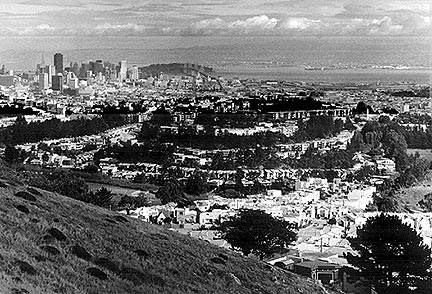
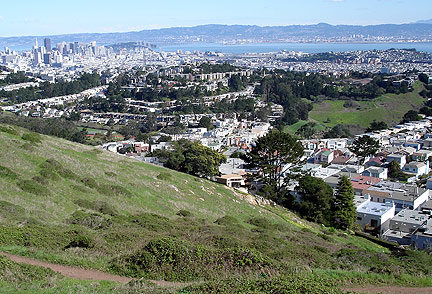
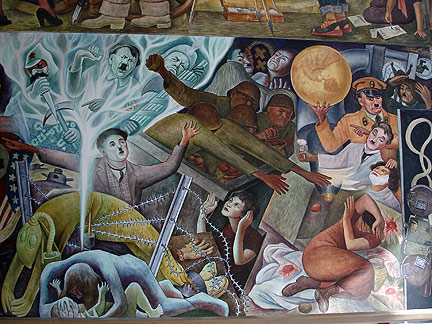
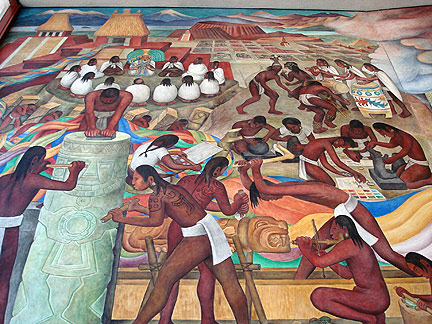

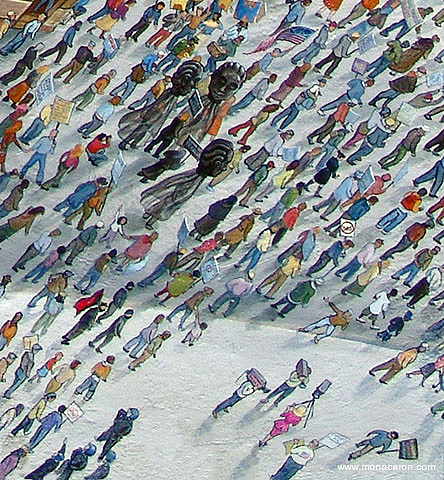
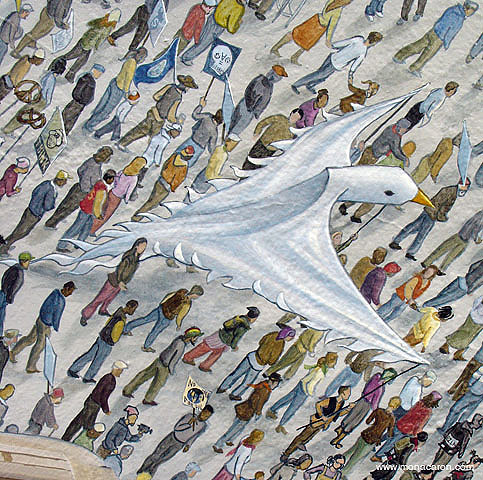
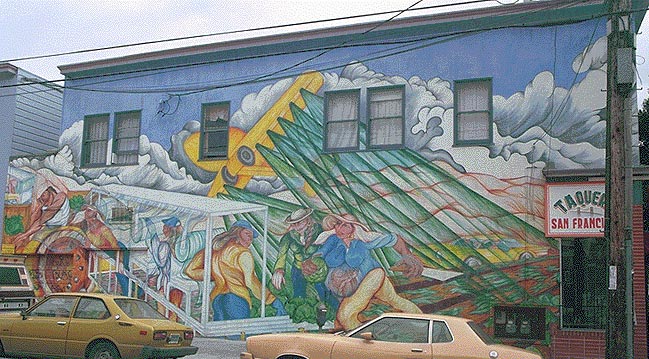
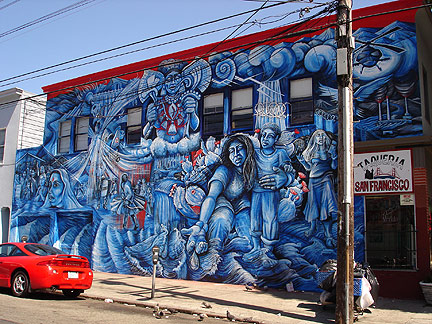











One march. Granted, it was all over the world and beautiful and it left you a little sad when the Great Liar just did what he wanted anyway.
I would like to offer a different thought though, since I attended Nam marched in San Francisco, Berkeley, all over Los Angeles where I was from) and in several other cities, just as a coincidence of time and being with friends.
The movement got started gradually, and continued to build. There were marches all over and people got killed and banks got burned we were generally ignored. The bombings and napalmings and agent orangings continued.
But slowly either corporate america or the silent majority started realizing that there was something behind all them instigators bad ways. Eventually the corporates realized that the economy relied upon a certain amount of social cohesion and realized they had to care instead of ignore. Or maybe people saw a march themselves and realized they weren’t alone in their anti-war feelings. Or maybe whatever.
It was marketing and you never really know the stretch of your marketing, but there is one rule. Repeat constantly and consistantly. Find the button that will make the point. Keep hitting that button.
Blogging and sharing ideas to a converted mass is great. It is a new and great way to refine and glorify. But it is not a great way to get the majority of people energetic enough to do something. If the Bushies were to see millions month after month, if the Dems saw millions month after month, things could be different. The Dems might be brave and the Pugs might be fearful.
But we gave in to early to the mocking of their bought and bribed media.
Sad
“…But the tired old form of the mass march under monitors and microphones has clearly lost whatever political power it once may have had.”
I have always wondered if these marches should start as soon as we walk outside our door. Rather than protest in a certain local immerse/engage the entire community. Or is this too much like advertising?